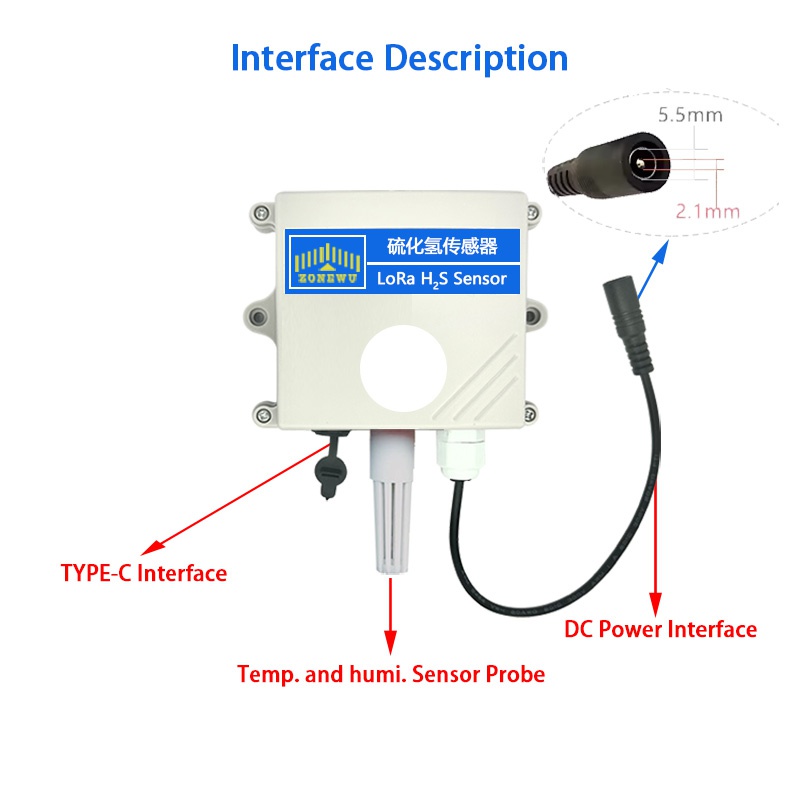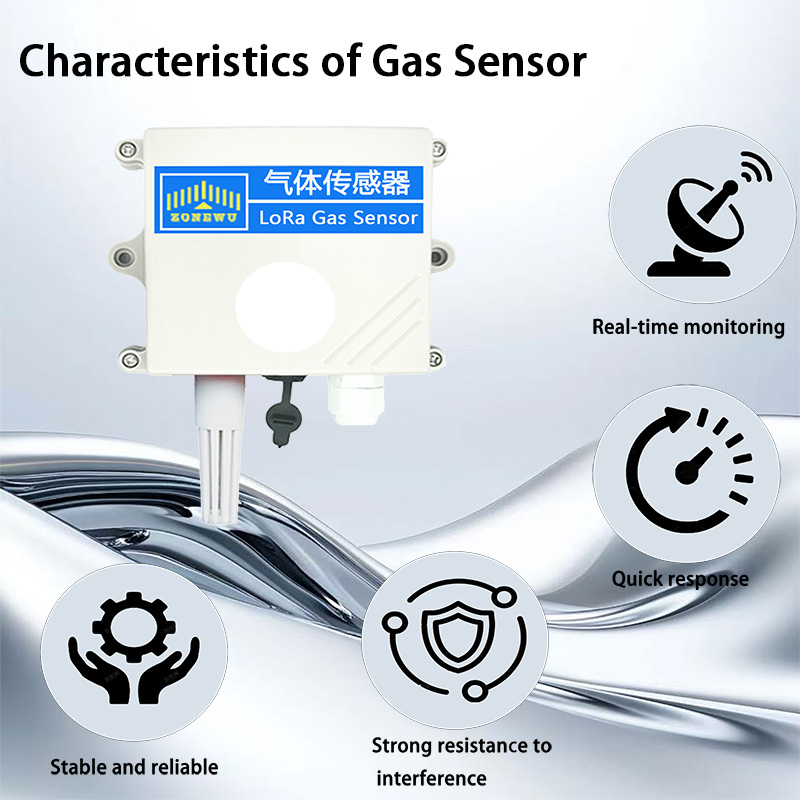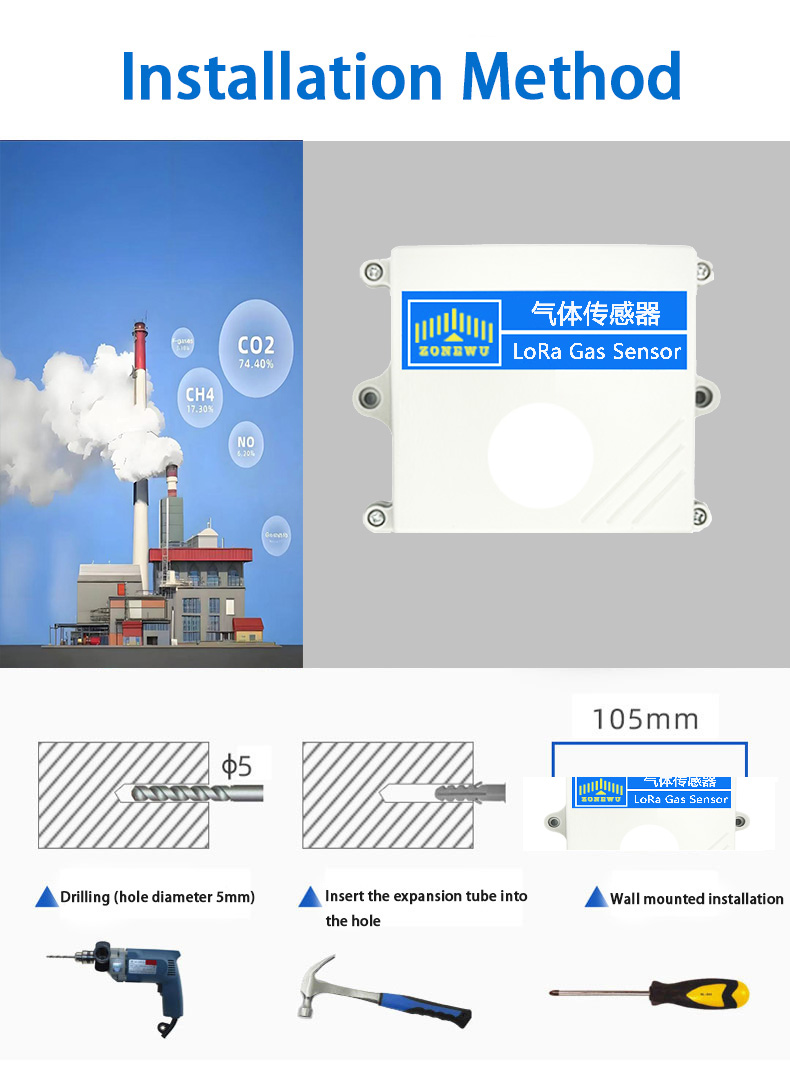xiamen ZoneWu LoRaWAN H2S gas sensor, can collect, monitor and transmit data, built-in hydrogen sulfide, temperature and humidity sensor, can measure the concentration of hydrogen sulfide, temperature and humidity in the environment in real time. It is sensitive, accurate and stable, supports the standard LoRaWAN protocol, and can communicate over long distances.
Product Model :
LW301-H2SPower Supply Mode :
Battery or External DCFrequency :
CN470/IN865/EU868/RU864/US915/AU915/ KR920/AS923-1&2&3&4MAC Version :
LoRaWAN 1.0.3Mode :
OTAA Class A/CWeight :
120gWireless LoRaWAN H2S Environmental Sensor
xiamen ZoneWu LoRaWAN H2S gas sensor is a new type of wireless sensor made with LoRaTM spread spectrum modulation technology, which is specifically used to detect hydrogen sulfide gas.
xiamen ZoneWu LoRaWAN Gas Sensor H2S Sensor Features:
This device has a comprehensive function, can collect data, and also stare at the environment conditions in real time, and can transmit data to the outside world, which is a "versatile hand."
It contains hydrogen sulfide (H2S) sensors, as well as temperature and humidity sensors, which can sense changes in the surrounding environment in all directions.
It uses three-electrode electrochemical gas sensor and high-performance microprocessor to detect hydrogen sulfide gas in the environment, and at the same time uses the built-in temperature sensor to compensate for the temperature, ensuring that the gas concentration measured is accurate.
If something is wrong in the field environment, it can report data exceptions immediately, and will proactively report the exceptions as soon as the numerical limits set in advance are reached.
There are especially many applications, such as hydrogen battery processing, medical applications, chemical industry and steel industry, where it can be seen to play a role.
complete functions, precise detection, rapid response, can adapt to the needs of different industries, and provide strong guarantees for safety and production in various fields.
Technical Parameters
|
Power Supply |
5~28VDC |
|
Weight |
120g |
|
Operating Emperature |
Temperature: -20~50 ℃ Humidity: 15% to 90% RH without condensation |
|
Measuring Principle |
Electrochemistry |
|
Measuring Range
|
H2S: 0~10 ppm |
|
Temp: -40~+80 ℃ |
|
|
Humi: 0~99.9 %RH |
|
|
Resolution Ratio |
H2S:0.01ppm |
|
Lifespan |
<2 years |
|
Frequency |
CN470/IN865/EU868/RU864/US915/AU915/ KR920/AS923-1&2&3&4 |
|
Mode |
OTAA Class A/C(Default: Class C) |
|
Reporting cycle |
External power supply:10min(Default reporting cycle) |
|
Communication Protocol |
LoRaWAN,LoRa TDMA Networking |
|
Equipment information (Reference) |
AppEUI:0000000000000001 DevEUI:aaaa202404150001 AppKey:00001111222233334444555566667777 MAC Version:LoRaWAN 1.0.3 |
Product Applications
1. High sensitivity and fast response: able to issue an alarm in a timely manner before the concentration of hydrogen sulfide reaches a dangerous level.
2. Real time monitoring: achieve all-weather and all-round monitoring of hydrogen sulfide concentration through sensor networks.
3. High accuracy and stable reliability: Ensure the accuracy of measurement data, help enterprises optimize production processes, and reduce harmful gas emissions.
4. Strong anti-interference ability: The special catalytic electrode preparation technology effectively avoids interference from other gas substances.
5. Wide working temperature range: capable of stable operation in an environment ranging from -40 ° C to 55 ° C, meeting high-precision measurement requirements.
Detailed Images


 m
m
Common knowledge of H2S
How does a hydrogen sulfide sensor detect hydrogen sulfide gas
Hydrogen sulfide sensors usually use electrochemical principles, utilizing three electrodes to electrochemical gas sensors, When hydrogen sulfide gas enters the sensor, an oxidation reduction reaction occurs on the electrode, thereby producing an electrical signal proportional to the concentration of hydrogen sulfur sulfide. The concentration of the hydrogen sulfate is determined by the detection and treatment of the electrical signal.
Does the hydrogen sulfide sensor need to be calibrated regularly
Need. In order to ensure the accuracy and reliability of sensor measurement, it is usually necessary to regularly calibrate the hydrogen sulfide sensor, and the calibration cycle is generally six months to one year, which can be adjusted appropriately according to factors such as the use environment and frequency.
What is the detection range of the hydrogen sulfide sensor
The detection range of different models of hydrogen sulfide sensor is different, generally the common detection range is between 0-100ppm (one millionth) to 0-10,000ppm, and the sensor with suitable detection range can be selected according to the specific use scene and demand.
Application Scenarios

Industrial production
Waste gas emission monitoring: Conduct real-time monitoring of industrial waste gas emissions to ensure that waste gases meet emission standards and reduce pollution to the environment.

Environmental inspection
Air quality monitoring helps people understand air quality and protect the environment and health by detecting harmful gases such as sulfur dioxide.

Safety protection
In coal mines and tunnels, gas sensors detect toxic and harmful gases such as methane and warn against accidents.
A:Yes,we can provide you with OEM services and design housings and logos.
3.DO you offer free samples?
A:Sorry,we don't offer free samples. After ordering in bulk, we will deduct the sample fee from the second order.
Why Choose ZONEWU